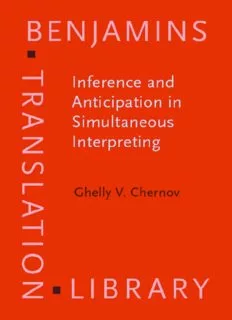Table Of Content<DOCINFOAUTHOR""TITLE"InferenceandAnticipationinSimultaneousInterpreting:Aprobability-predictionmodel"SUBJECT"BenjaminsTranslationLibrary,Volume57"KEYWORDS""SIZEHEIGHT"220"WIDTH"150"VOFFSET"4">
InferenceandAnticipationinSimultaneousInterpreting
Benjamins Translation Library
TheBenjaminsTranslationLibraryaimstostimulateresearchandtrainingintranslationand
interpretingstudies.TheLibraryprovidesaforumforavarietyofapproaches(whichmay
sometimesbeconflicting)inasocio-cultural,historical,theoretical,appliedandpedagogical
context.TheLibraryincludesscholarlyworks,referenceworks,post-graduatetextbooksand
readersintheEnglishlanguage.
ESTSubseries
TheEuropeanSocietyforTranslationStudies(EST)Subseriesisapublicationchannelwithin
the Library to optimize EST’s function as a forum for the translation and interpreting
research community. It promotes new trends in research, gives more visibility to young
scholars’work,publicizesnewresearchmethods,makesavailabledocumentsfromEST,and
reissuesclassicalworksintranslationstudieswhichdonotexistinEnglishorwhicharenow
outofprint.
Generaleditor Associateeditor
GideonToury MiriamShlesinger
TelAvivUniversity BarIlanUniversity
Advisoryboard
MarilynGaddisRose ZuzanaJettmarová JuanC.Sager
BinghamtonUniversity CharlesUniversityofPrague UMISTManchester
YvesGambier WernerKoller MarySnell-Hornby
TurkuUniversity BergenUniversity UniversityofVienna
DanielGile AletKruger SonjaTirkkonen-Condit
Université Lumière Lyon 2 and UNISA UniversityofJoensuu
ISITParis JoséLambert LawrenceVenuti
UlrichHeid CatholicUniversityofLeuven TempleUniversity
UniversityofStuttgart FranzPöchhacker WolframWilss
EvaHung UniversityofVienna UniversityofSaarbrücken
ChineseUniversityofHongKong RosaRabadán JudithWoodsworth
W.JohnHutchins UniversityofLeón Mt.SaintVincentUniversityHalifax
UniversityofEastAnglia RodaRoberts SueEllenWright
UniversityofOttawa KentStateUniversity
Volume57[ESTSubseries2]
InferenceandAnticipationinSimultaneousInterpreting:
Aprobability-predictionmodel
ByGhellyV.Chernov
EditedwithacriticalforewordbyRobinSettonandAdelinaHild
Inference and Anticipation in
Simultaneous Interpreting
A probability-prediction model
Ghelly V. Chernov
Editedwithacriticalforeword
byRobinSettonandAdelinaHild
JohnBenjaminsPublishingCompany
Amsterdam(cid:1)/(cid:1)Philadelphia
TM Thepaperusedinthispublicationmeetstheminimumrequirements
8
ofAmericanNationalStandardforInformationSciences–Permanence
ofPaperforPrintedLibraryMaterials,ansiz39.48-1984.
LibraryofCongressCataloging-in-PublicationData
GhellyV.Chernov
InferenceandAnticipationinSimultaneousInterpreting:A
probability-predictionmodel/ GhellyV.Chernov,Editedwitha
criticalforewordbyRobinSettonandAdelinaHild.
p. cm.(BenjaminsTranslationLibrary,issn0929–7316;v.57)
Includesbibliographicalreferencesandindexes.
1.Simultaneousinterpreting.I.Setton,Robin.II.Title.III.Benjamins
translationlibrary;v.57.IV.Benjaminstranslationlibrary.ESTsubseries.
P306.95.C49 2004
418’.02-dc22 2004059145
isbn9027216630(Eur.)/1588115836(US)(Hb;alk.paper)
©2004–JohnBenjaminsB.V.
Nopartofthisbookmaybereproducedinanyform,byprint,photoprint,microfilm,or
anyothermeans,withoutwrittenpermissionfromthepublisher.
JohnBenjaminsPublishingCo.·P.O.Box36224·1020meAmsterdam·TheNetherlands
JohnBenjaminsNorthAmerica·P.O.Box27519·Philadelphiapa19118-0519·usa
JB[v.20020404] Prn:2/12/2004;9:26 F:BTL57CO.tex / p.1(42-96)
Table of contents
Editors’criticalforeword ix
Foreword xxiii
Abbreviationsandsymbols xxix
Chapter1
ThepsycholinguisticapproachtoSIresearch 1
1. SIandthelinguistictheoryoftranslation 1
2. ThemethodologicalbasisofapsycholinguisticapproachtoSI 3
3. TheobjectofSIpsycholinguisticresearch 6
Chapter2
Speed,memoryandsimultaneity:Speechprocessingunder
unusualconstraints 11
4. SimultaneityinSI 11
5. Timeconstraints 15
6. Externallycontrolledpaceofactivity 16
7. Recitedtextsvs.improviseddiscourse 18
Chapter3
Thesemanticandpragmaticstructureofdiscourse 25
8. Wordmeaning 25
9. Polysemyandsynonymyindiscourse 28
10. Componentialanalysisofmeaning 28
11. Semanticagreement:Acombinatorylawofdiscourse 29
12. Semanticredundancyindiscourse 32
13. Semanticredundancyindiscourse:Anexample 36
Chapter4
Semanticstructureandobjectivesemanticredundancy 39
14. Theconceptofsense 39
JB[v.20020404] Prn:2/12/2004;9:26 F:BTL57CO.tex / p.2(96-129)
Tableofcontents
15. Themeofcommunication,objectofanutterance,
andforegrounding 42
16. Thesemanticstructureofdiscourseanditsbasiccomponents 46
17. SemanticstructureastheobjectandproductofSI 53
Chapter5
Communicativecontextandsubjectiveredundancy 57
18. Implicitsenseandinference 57
19. Linguisticinference 61
20. Cognitiveinference 65
21. Situationalinference 70
22. Pragmaticinference 71
23. Thecommunicativesituationofsimultaneousinterpretation 72
24. Discourseequivalent 77
25. Interdependenceofsituationandsemanticstructure
ininferencing 78
26. Situationalfactorsincomprehension:Anillustration 82
Chapter6
AprobabilityanticipationmodelforSI 91
27. Theprincipleofanticipatoryreflectionofreality 91
28. Messagedevelopmentprobabilityanticipation 92
29. Multilevelredundancyandprobabilityanticipation 93
30. Cumulativedynamicanalysis(CDA)andtherange
ofprobabilityanticipation 96
31. TowardstheinternalprogramfortheTLutterance 104
Chapter7
Themeandcompression 107
32. Thethematic(referential)componentofdiscourseinSI 107
33. RedundancyinSpanishpublicspeaking 111
34. TypesofspeechcompressioninSI 113
Chapter8
Rhemeandinformationdensity 121
35. Perceptionbyinformationdensitypeaks 121
36. Lossofinformationduetoamissedrheme 123
37. Strongrheme,weakrheme,chainofreferents 124
JB[v.20020404] Prn:2/12/2004;9:26 F:BTL57CO.tex / p.3(129-179)
Tableofcontents
38. Thedominantevaluativerhemeinapoliticaldiscourse 127
39. RenderingtheevaluativecomponentinSI 129
Chapter9
Syntaxandcommunicativewordorder 135
40. TheinternalprogramfortheTLutterance:Wholeorbroken? 135
41. Wordorderandcommunicativesyntax 145
42. Syntacticcomplexity,logicalsequenceandworkingmemory 157
43. Shortandextendedpredicates 159
Chapter10
SIandAnokhin’stheoryofactivity 165
44. SIasafunctionalsystem 165
45. Probabilityanticipationasamultilevelmechanism 169
46. Self-monitoringorfeedback 178
47. TheefficiencyoftheSIcommunicativeactandtheSIinvariant 181
Chapter11
AnticipationandSI:Anexperiment 185
Chapter12
Conclusion 199
Notes 201
References 213
Transcripts
AppendixA
BuenosAirescorpus–UN,1978,Experiment
inRemoteInterpreting 223
AppendixB
UnitedNationsGeneralAssemblysessions 241
AppendixC
TextswithtwotypesoftestitemsusedasinputinanSIprobability
anticipationexperiment(Chernov1978) 247
Nameindex 253
Subjectindex 257
JB[v.20020404] Prn:6/12/2004;15:19 F:BTL57ED.tex / p.1(41-115)
Editors’ critical foreword
RobinSettonandAdelinaHild
Ghelly Vassilievich Chernov (1929–2000) belonged to the first generation of
post-war Russian conference interpreters servicing Soviet delegations at the
United Nations through the Krushchev era, the height of the cold war, and
decolonisation,andwasHeadoftheRussianinterpretationunitattheUNin
NewYorkfrom1976to1982.InRussiaaselsewhere,seniorinterpreterstrained
thenextgeneration,acalling which fitneatlywith aparallelacademiccareer.
Withtwodoctorates(Translationin1955andInterpretationTheoryin1980),
Chernovoccupiedsuccessiveposts,firstattheMauriceThorezInstitute(later
Moscow State Linguistic University) as Assistant Professor of English Trans-
lation and Interpretation, in 1967, then Chair of Interpretation from 1970,
and later, from 1991, as President of the Moscow International Interpreting
School(MIIS)beforereturningtoMSLUasProfessorofInterpretationTheory,
History,andPracticefrom1995untilhisuntimelydeathin2000.
Chernov’smaincontributiontointerpretingstudieshastraditionallybeen
seen in his highlighting of redundancy as a key factor in SI comprehension
and his emphasis on the psychological process of ‘probability’ anticipation
(forward inferencing) as the central cognitive process making SI possible.
His standing in the discipline and the originality of his work amply justify
publication of his seminal contribution in English at this time. His decision
to publish this work in English (as explained in the author’s foreword) was
motivated partly by a concern to reach a wider readership and partly by a
need to express affinities with some recent work in interpreting studies and
inpragmatics,specificallythepost-GriceanschoolofRelevancetheory.
Like a few other practitioners and trainers in Western Europe in the
1960s, Chernov was intensely curious about simultaneous interpreting, and
had as many exciting intuitions and ideas as the next man or woman in
the booth or trainer of conference interpreters. He did, however, take the
step from speculation to empiricism, and looked for backing for his ideas in

